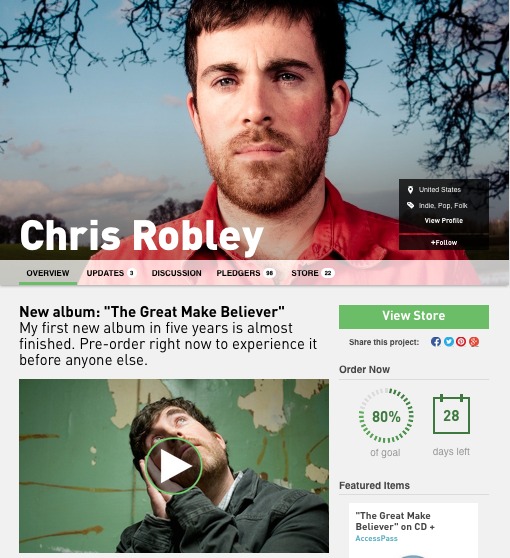 I’m now thirty days into a PledgeMusic campaign to fund my first new album in five years. The following article combines my own thoughts on building and running a (hopefully) successful campaign with excerpts from an interview with Benji Rogers, the founder and president of PledgeMusic.
I’m now thirty days into a PledgeMusic campaign to fund my first new album in five years. The following article combines my own thoughts on building and running a (hopefully) successful campaign with excerpts from an interview with Benji Rogers, the founder and president of PledgeMusic.
—-
“The recorded music industry has focused solely on the end product. They’ve created thousands of ways to consume music, but never focused on reasons to participate.” – Benji Rogers
Funding vs. experiential direct-to-fan sales
PledgeMusic is not a crowdfunding platform. Or perhaps more accurately, it’s not merely a crowdfunding platform. It’s a tool that allows superfans to unlock access to their favorite artists’ creative journeys.
Fans gain this access by pre-ordering albums or other signed exclusives and experiences from the artist.
Artists then invite “pledgers” to come behind the scenes for the entire creative process (from the writing of the songs to the album release party) by sharing frequent photo, video, audio, and written updates about their progress. Ideally, these updates provide additional context for fans to share the music and say “I was there while it was happening.”
Benji Rogers, the founder and president of PledgeMusic, is adamant about this distinction between funding and process. “Crowdfunding campaigns end,” Rogers says. With PledgeMusic, artists don’t engage with fans for a brief funding period and then disappear until the album’s launch; they keep fans invested for the life of the project and beyond.
Deciding on a crowdfunding platform
Oddly enough, this focus on process is one of the reasons I didn’t seriously consider using PledgeMusic when I started comparing crowdfunding platforms. PledgeMusic seemed like a good solution for an artist headed into the studio who wants to invite fans along for the whole ride (while also making pre-orders available from Day #1).
But my new album had been entirely recorded and mixed already. I just needed to raise funds for the final few steps (including mastering and manufacturing), and I didn’t yet see that there was any real PROCESS left to be shared with fans.
After speaking with the folks at PledgeMusic, though, it became clear that there were a number of steps left in the journey (choosing mixes, sequencing the track order, designing album art, etc.), and those steps could be a series of “reveals” that would keep fans excited.
So I started weighing my options: Kickstarter? IndieGoGo? RocketHub? PledgeMusic?
The fees that each crowdfunding service charges
Kickstarter keeps 5% of the funds raised, plus another 3-5% goes to Amazon.
IndieGoGo keeps 4% if you meet your fundraising goal, and 9% if you don’t. (Plus payment processing fees of 2.9%).
PledgeMusic keeps 15% (yes, you read that right: 15%).
Considering campaign durations, competition, and funding structures
With Kickstarter, you must meet your goal (usually within 30-40 days, though a campaign can run longer) in order to collect any funds, so the pressure is on. Plus, the competition is steep. Thousands of campaigns are active at once on the Kickstarter site.
When I say “competition,” I’m not just talking about your campaign competing with others for audience attention. I’m talking about competing for the attention of Kickstarter staff should you need guidance or a solution to a problem you’re experiencing with their system during the campaign (which happened to a friend of mine).
With IndieGoGo, you can still keep the funds you’ve raised even if you don’t meet your goal, but here too there are TONS of campaigns going on at once. You can run longer campaigns on IndieGoGo also, but…
With PledgeMusic, I knew that it was inherent to the platform that a campaign could run right up until the album release.
 And they have multiple campaign options for funding/pre-sales, including:
And they have multiple campaign options for funding/pre-sales, including:
1. ‘Funding period’ campaign – This kind of campaign gives you X amount of days to “fund” and then switches to a pre-sales focus.
2. ‘Pre-order’ campaign – There’s no funding target, just the ability to purchase the album before it’s released (and in many cases, before it’s even been made).
3. ‘Number of units’ campaign – This campaign type lets you say to your fans, “once we hit a certain quantity of orders, we’ll produce the product and deliver.”
I ended up running the first kind of campaign on PledgeMusic, and set the funding period at 60 days. Running a longer campaign was important to me because I knew I’d be juggling a few things this Spring, not only job and family and work travel, but also helping my parents get ready to move, playing gigs and doing poetry readings, watching Top of the Lake on Netflix, etc.
I wanted some breathing room in the campaign so I wouldn’t have to sprint the whole time. This might not actually be great advice if you’re looking to do a crowdfunding campaign (it’s a lot of work and you should be prepared for it), but I wanted to know that I could let a few days go by without thinking about the funding/pre-sales effort — and not have a sense of doom or panic after returning from the break.
So, … I planned this campaign according to the realities of my life right now.
Then there was the matter of good old-fashioned customer service
A few of my musician friends have told me horror stories about trying to get in touch with other crowdfunding platforms during the middle of a campaign when things were feeling most urgent. From what I was told, the response time was terrible and the emails were impersonal (and often unhelpful).
With PledgeMusic, I knew I’d have a personal representative (they call them “campaign managers”) in my time zone to help guide me through the whole process, from creating the campaign, pricing the exclusives, right up to the end.
Knowing that I could work one-on-one with someone at PledgeMusic helped justify the 15% fee they take.
This was especially important to me because it’d been a long time since I released my previous album — five years! In that time I’d moved across the country (3000 miles from my musical home), had a baby, and played far fewer shows. All of these factors meant that I was feeling a little out-of-touch with my (modest) fanbase. It’s been so long since I’ve put out new music or toured; will anyone care?
Setting the goal
That fear was very real for me, but knowing that someone at PledgeMusic would have a personal investment in the success of my campaign helped me combat some of that anxiety.
PledgeMusic campaign managers will look at your music career milestones, the size of your active email list, your social media presence, plus any other relevant circumstances (like, “hey, I only have ten diehard fans, but they’re all billionaires!”) and help you determine if your funding goal is viable.
PledgeMusic has a 90% success rate at this (way higher than other crowdfunding platforms), so again, working with someone there to set a realistic target was great for launching my campaign with some measure of confidence.
The terror of asking
OK, so let’s get to the heart of it: most artists are afraid of failure and rejection. You can ask your fans to join you on your creative journey; you can ask them to pre-order your album; you can ask them to help you fund your tour… but what if they say NO?!
Often there’s an even more basic fear though: before you can be rejected, you have to ASK — and asking makes you vulnerable. Will you be seen as pesky, needy, or unsuccessful if you have to “stoop” to asking?
If you’re dealing with this fear, I’d first recommend you read Amanda Palmer’s The Art of Asking — or at least watch her TED talk — before you launch a crowdfunding campaign. Her thesis (in a nutshell) is that by asking, you’re actually giving someone the gift of access, connection, and trust.
Second, read “25 music crowdfunding mistakes that can make you look like a money hungry fool.” There’s a lot of good info in there about how to approach your campaign with confidence and genuine respect for your fans.
Third, consider what Benji Rogers says on the subject: “All music is funded by fans; it’s just a question of when that payment is taken. You’re going to make this music anyways. Why not get it out there in the coolest way possible?”
Again, “the coolest way possible” means your fans can watch the process as it unfolds. It’s about access and experience, not simply consuming the end product from iTunes or Soundcloud or Spotify.
To be sure, that exclusive access is monetized in the form of a pledge ($$$) that will help you further your creative goal, but giving your fans the ability to purchase at any level they’re comfortable is a win for everyone.
“Mark Mulligan published a research paper recently saying that 61% of all paid music consumption is by superfans,” says Rogers. “And yet 9 out of 10 times, an average artist sends superfans to a place where they can spend the LEAST amount possible, being streaming, or the fan could maybe buy a download from iTunes, and that’s it.”
Some industry experts estimate that artists and labels collectively are leaving billions of dollars on the table every year by not giving superfans more options when it comes to products, experiences, and access to the creative process.
But it’s not just about price; it’s also about widening the timeframe for sales.
“I saw a tweet the other day from the band CHVRCHΞS. They’re in the studio,” says Rogers. “What can I do? I can notice it. I can re-share it to people. But then they can’t do anything with it.”
When an artist steps into the studio, there is excitement and uncertainty. Why not let your fans spend money and participate right from the start?
“It’s the artist or label’s fault, NOT the superfan,” Rogers says. “The average spend per fan on PledgeMusic is $55. Would you rather have 1000 people spending $55, or 1000 people spending $13.99, or 1000 people paying a streaming service $9.99 to listen to that same song?”
Why PledgeMusic keeps your monetary goal private
Unlike other crowdfunding platforms, PledgeMusic does not disclose the dollar amount you’re trying to raise.
I went back and forth in my mind about this one before deciding on PledgeMusic. On the one hand, I feel like people want to see how their contribution helps the overall effort — and we’ve been trained to measure that in $$ signs.
On the other hand, focusing on the monetary goal puts pressure on the content and end result to be worth a certain amount. And as Rogers points out, it can become a Pandora’s Box of questions: Why did you spend so much on studio time? Couldn’t you record at home for cheaper? Why the photo-shoot in Paris? Why does mastering cost so much money?
All of these questions becomes a distraction from what’s most import: process and access.
Great music can be made on tiny budgets, and terrible albums can cost hundreds of thousands of dollars to record. Would your audience be able to separate the quality from the dollar amount? Hopefully so, but with PledgeMusic, they’ve taken that concern out of the equation altogether.
Getting into the right mindset
Another thing that holds artists back sometimes (besides that fear of asking) is the fear that people won’t find what you’re doing all that interesting.
Remember though, while your music might not seem so thrilling to you after you’ve worked on the same song for eleven months straight, it’s totally exciting and brand new to your fans.
Similarly, crowdfunding as an endeavor might seem old-hat to musicians nowadays, but for your fans it’s a cool way to connect with you and your art.
Before you launch a campaign, try to step outside of yourself and get a fresh perspective on your own music. Benji Rogers says, “Most people don’t follow their dreams. Musicians do. So just letting people get a glimpse into the process is remarkable.”
—
Ok. So we’ve talked a lot of theory so far. Now, getting down into the nitty-gritty of a campaign…
Building and running your PledgeMusic campaign
Chances are you’ll be working on many of these pieces at once, but for simplicity’s sake I’ve broken them into sections.
Coming up with exclusives
You’re going to offer a number of products and experiences across a wide price range in order to appeal to pledgers at all different spending levels. Yes, a pledger can choose to buy your lowest priced exclusive and then tack on an extra monetary amount of their choosing, but having a bunch of different exclusives helps guide your fans towards what they’re most comfortable spending.
So what should you offer? Here’s a list of obvious options:
* signed CD
* signed vinyl
* handwritten lyric sheets
* signed set lists
* posters
* t-shirts
* house concerts
* backstage passes (meet and greet)
* pledgers’ names in the album credits
* executive producer credit
* instruments
* Skype lessons or discussion
* your discography
* recording a cover song of their choosing
Then you can also get more creative, personal, or genre appropriate: the fog machine from your last show, a chance to bake a cake with your favorite singer, etc.
My wife is an acupuncturist, so I have an exclusive where if you live in our area, we’ll come to your place and she’ll give you an hour-long treatment. I’m also a published poet, so some of my exclusives involve my writing: a limited-edition poetry chapbook that’s typeset by hand, a poetry broadside, a personalized poem on a postcard, autographed copies of POETRY Magazine with one of my poems in it, etc.
You can always ASK your fans what they want, too — even after you’ve launched the campaign.

When it comes to pricing these exclusives, you really need to consider fulfillment and shipping costs. My campaign manager was very helpful in this regard and suggested a number of price changes before the campaign went live. He also helped me set up the shipping costs to account for international orders.
One thing to remember, though: it’s OK to price things on the high side. You’re not competing with Amazon here. This is about offering your fans an experience, which includes the experience of making and fulfilling these exclusives.
Create your campaign video
The video really is the centerpiece of your campaign. Most people who visit your PledgeMusic page will watch the video first, or they’ll have been drawn to your PledgeMusic page by seeing the video on Facebook, Twitter, or YouTube already.
When it comes to creating your video, Benji Rogers says, “Think like a fan. What would YOU like to see?”
If your music is weird and quirky, make the video reflect that. Are you an earnest folk singer? Make your video heartfelt and direct.
Rogers also suggests you have a ‘Don’t bore us; get to the chorus’ mindset when creating the video. Two minutes is a fine length. Get right to the heart of it!
Here’s an excerpt from PledgeMusic’s video guidelines:
We see a mix of approaches to the video being effective; talking heads, voiceover with text graphics, live audio/video and a mix of text/voiceover. It’s best to be genuine and use specific wording.
A general outline of how the video could be put together:
1. Intro: The story of the entire campaign. Brief bit on what you’ve been up to. Not a ton of history, because most fans are already familiar with it.
2. The project: What’s the concept, where it’ll be recorded, etc.
3. Partnering with PledgeMusic to pre-order: basically that they will receive the download of the record before the public, behind the scenes updates from the band, cool exclusives, etc.
4. How to pledge your support: directing everyone to the Store down below
5. Mention of a charity (if applicable) and the connection to the band
6. A good wrap up and call to action to get involved.
7. Text graphic with a call to action like “Pre-order the new record” and the project’s URL plus the PM logo if you want. We can help with this last part as well.
Words to use: pledge, pledger, exclusives, pre-order, bundles
Words NOT to use: donate, charity, incentive, perks, rewards, backer, tiers.
—

Whether it was wise or not, I actually shot a longer video. I’d essentially followed the formula above for the first 2.5 minutes of my video (so all the essentials are taken care of quickly), but then the video plays for another couple minutes with extra context about the project, more quotes from some of the musicians I collaborated with, and a few extra bits of humor at the very end. I’d finished editing the video before I’d started building my campaign with PledgeMusic, so it wasn’t really that I was ignoring their advice so much as that I hadn’t heard it yet.
Anyway, my campaign manager recommended we launch the campaign with the video as-is, but we’d keep an eye on things, and if we felt like the video length was a roadblock to people pledging we could split it into two videos (the first 2.5 minutes then being the official campaign video), and the second half being an update video to share later on.
As I’m writing this the project is 80% funded with 30 days left to go, so I don’t think the video length was too much of an issue for me. That being said, if I could do it over again, I probably would’ve shortened it and left the rest of the material for video updates.
Writing your project description
Once people have watched your video, they’ll scroll down and see your project description. This text should focus on the WHY of the project. What’s your intention behind it? What does it mean for you to have created this work, and what will your fans get if they join you on your journey?
For both the description and the video, look at other successful campaigns for reference. Borrow whatever you think works best.
Reviewing your campaign before launch
Once you’ve completed all the information (description, video, exclusives, etc.), you will send your campaign to your campaign manager for review. This was super helpful for me, and we went through 2 or 3 rounds of revisions before it was finally ready for launch.
Preparing for launch
I felt like I was pretty prepared — but even so, once the campaign went live I found myself scrambling. Why? Well… as soon as you hit the “launch” button you’ll want to start directing all your website traffic, social media followers, and email subscribers to your PledgeMusic campaign page. But you can’t actually make any of those updates, links, or banners live until the campaign is active.
![Instagram Photo]()
The best advice I can give is that you should give yourself three or four hours after the campaign is launched to get the rest of your online presence up to speed.
So, what should you get ready?
Design assets for social media and website
Twitter headers. Facebook profile pictures. YouTube channel art. It’s prime real estate, and usually the first thing someone sees when they’re on one of your social profiles. You should use this visual space to let people know about your PledgeMusic campaign (and link them to it).
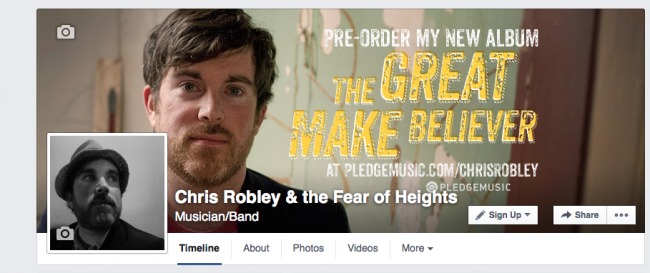
Since every one of those images will have slightly different dimensions, you’re going to need to create four or five different versions — but for simplicity’s sake I’d recommend keeping them all similar in terms of font, messaging, art, etc.

For specific info on the dimensions of YouTube Channel art, Facebook cover photo, and Twitter and G+ profile headers, check out our article “Dimensions of social media images.”
Create a splash page for your website
Add a splash page to your website so all new visitors will see an announcement about your campaign (and a link). I used an image for my splash page, and the image itself is the link.
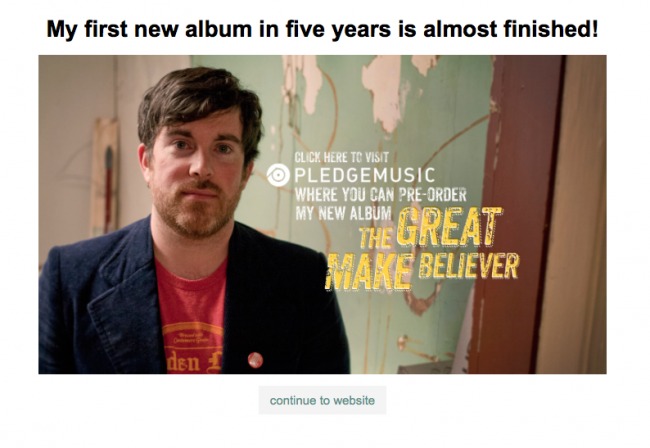
I used a WordPress plugin called “WP Splash Page” to create mine, but there are plenty of options out there.
Website news announcement
I created a blog post announcing my campaign and featured it at the top of the news section on my website’s homepage. It helps to have this written beforehand, save it as a draft, and publish it once the campaign goes live.
I’ve also posted on my blog as new updates go live on PledgeMusic.
Email your list
With most PledgeMusic campaigns, emails yield the highest conversion, so you should have this email designed and ready to send upon launch. You can even have your campaign manager take a look and make suggestions before sending.
As PledgeMusic advises:
* Keep the message in tune with your project messaging.
*
Optimize your subject line with a clear call to action, i.e. “Pre-order the New Album” or “Join us in releasing new music.”
* Sell the idea of community and inclusion, not the individual exclusives (though highlighting unique items or experiences is recommended).
* Let the audience know the value proposition (how they will be privy to exclusive updates).
* Ensure a minimum of 3 links or hyperlinks out to your campaign.
* Embed your campaign badge below your signature.
Which brings us to…
Embed your campaign badge on your website
The campaign badge is both a tracker of your progress and a link right to your campaign page. It looks like this:

I pasted mine into a sidebar widget on my WordPress site. Just make sure it’s prominently featured.
Promote the campaign on Facebook
So far, Facebook has proven to be an incredibly effective way of getting pledgers to contribute to my campaign. Here’s a few things you should try:
1. Upload a new cover photo w/ link in description. The first thing I did was add a cover photo image to my band page (as mentioned earlier). In the image description I added a few sentences about the campaign and a link to PledgeMusic.
2. Upload your campaign video. You could share your video to Facebook FROM your PledgeMusic account — and Facebook will pull the media into the feed. BUT… when it comes to displaying your content to fans, Facebook has been heavily favoring videos that have been uploaded directly to Facebook.
I uploaded my campaign video to Facebook and used this as part of my announcement post. After three or four days had passed, and its organic reach slowed down, I then paid to promote the post to my fans on Facebook. After another week or so, I duplicated the video post and paid to promote it to friends and friends of friends.
3. Post lots of videos and pictures. As PledgeMusic says, “Facebook’s algorithms prioritize posts containing media; therefore, when you post anything regarding your campaign, be sure to include some form of media such as an image or video.”
4. Put the URL to your PledgeMusic campaign towards the beginning of all Facebook posts. Your text is truncated in longer posts, so you want to make sure someone can click the link without having to hit the “see more” button.
Share your campaign on Twitter
For me Twitter hasn’t been nearly as effective as Facebook, but it’s still driven pledgers to my campaign, so I’d recommend you put some energy into it. Here’s a few things to try:
1. Link your accounts. You’ll want to make sure your PledgeMusic account is linked with your Twitter account (and your FB account, for that matter). This way every update you make on your campaign will be auto-tweeted.
2. Add a new header image, as mentioned earlier.
3. Add a link to your campaign page in your ‘bio’ or ‘website’ field.
4. Tweet often! Remember, the nature of Twitter is that info speeds by, so you can’t assume that all your Twitter followers will see every tweet you make.
Promote your campaign on YouTube
Again, add channel art with details about your PledgeMusic campaign. Then…
1. Upload your campaign video BEFORE the campaign launches and have it set to private. Once you activate your campaign, make the video public on YouTube.
2. Set your campaign video as your Channel Trailer for the duration of your campaign.
3. Put the URL to your PledgeMusic campaign page right at the top of the video description.
4. Use a YouTube fundraising card to link viewers on all platforms to your PledgeMusic page. For more info on using YouTube cards, click HERE.
5. Set your Featured Video to be your campaign video. A preview link will then be displayed on all your other videos.
Get creative on Instagram
Instagram doesn’t let you post direct links in your photo descriptions, so…
1. Change your website URL in your bio to your PledgeMusic campaign page.
2. Use an app like Over or WordSwag to add the PledgeMusic URL to your images. Here’s another example of how I did that:
![Instagram Photo]()
Switch any other prominent social links
If you’ve been sending people on Tumblr, Soundcloud, etc. to YOUR website, you should consider switching those links to your PledgeMusic campaign page for the life of the campaign.
Don’t worry about losing out on capturing email addresses. PledgeMusic will provide you with the email contact for every pledger.
Send a press release
Depending on the size of your fanbase, the story of your latest project and the availability of bonus content could be of interest to journalists and bloggers. They want the scoop first, and it doesn’t get much earlier than when you’re still MAKING the album.
Also, why premiere a track on Soundcloud when you can send people to PledgeMusic to hear the song AND pledge their support?
Note: there’s an option in PledgeMusic’s back-end system that allows you to give journalists free access to your updates.
Now write to everyone you know, personally
This is by far the most effective thing I’ve done. And unfortunately I put it off for a couple weeks, partially out of being super busy, and partially out of nervousness. You’re really putting yourself out there when you ask someone directly to pre-order your album, or pledge support, or however else you’re going to phrase it. But here’s the thing: not only does it work, you’ll also get to reconnect with folks you haven’t seen in a long time.
For the most part I’ve found that rather than being put off by a request from ‘out of nowhere’ to check out your campaign, it becomes a conversation starter, and your old friends, fans, and family can catch up and reminisce with you.
The key, of course, is to personalize each message. Sure, I start with a basic template, and I talk about the project first (more on that below), but then I make sure to let them know I’m talking directly to them, not a crowd.
So, 30 days into my campaign and I’ve only written to about 300 of my 1100 or so Facebook friends. I clearly have some sprinting to do in the weeks ahead. I really am kicking myself for not starting this process earlier, especially since it’s been THE most effective thing I’ve done. So my suggestion is to budget an hour every single night over the first 3 or 4 weeks specifically for the task of writing people individually.
Why talk about the project FIRST?
So, I said I make sure to talk about the project first in my personal messages. Why?
Here’s some advice from Ian Anderson’s article “25 music crowdfunding mistakes that can make you look like a money hungry fool:”
—
You think you should show some concern for the person you are talking to before you ask. Call it “buttering them up.”
But at about the 25:30 mark in the Simon Sinek video, he explains how the simple ordering of your request can be the difference between a Yes or a No.
He gives this example of what might happen when emailing someone with a request:
Hi Person,
Haven’t seen you in years. I hope you’re doing well. Congratulations on all you’ve been doing. It’s really amazing! We should grab coffee sometime. If you could do me a favor, I’m in an online contest where I can win a big prize and I was wondering if you’d vote for me. Hope you’re well, talk to you soon.
Thanks!
Kenny
As Simon points out, reading that email would leave you dismissive or maybe even offended and hitting DELETE!
But what happens when you get the same email with a change of order: request first, pleasantries second?
Hi Person,
I’m hoping you could vote for me in an online contest where I can win a big prize for my work. I haven’t seen you in years. I hope you’re doing well. Congratulations on all you’ve been doing. It’s really amazing! We should grab coffee sometime.
Thanks!
Kenny
This works better because the person knows what you want and then the pleasantries don’t seem like a thin veil of disguise. Instead, the person can be grateful for them as well as willing to consider the request.
When you put the Ask last, your pleasantries seem really disingenuous and can potentially offend the person you are communicating with, even though you have no intent of offending them in the first place.
—-
Another way you risk offending people is if you “ask” too many times, or even worse, ask after they’ve already contributed.
That’s why it’s crucial to…
Create a master spreadsheet
When you compile all your contacts on Facebook, Twitter, email, LinkedIn, etc. — you’ve going to find a lot of crossover, and it’s going to be hard to remember WHO you’ve written to if you’re working from separate lists that each have thousands of names on them. So be sure to keep close track of who you’ve written, what their response was (yes, no, maybe), and then make a note once they actually contribute.
Managing spreadsheets! I know that’s why you got into music, right? It seems like a headache at first, but better to have a headache than embarrass yourself in the middle a campaign.
Post frequent updates through PledgeMusic
The first bit of advice I have here is: get some of this stuff ready BEFORE you launch the campaign. If you’re sharing videos or MP3s, get them edited or mixed beforehand. The reason I say this is because you’re not going to have a whole lot of extra time DURING the campaign, so the more footage, mixes, and photos from the studio you can prepare beforehand the better.
![Instagram Photo]()
When you do post updates through PledgeMusic (they recommend posting every 3-5 days throughout the campaign), you can also share a 30-second preview on social media sites. If your fans want to hear or see more they’ll have to pledge, and they’re directed to the campaign page to do so. Another cool thing is that your pledgers can opt to syndicate your updates on THEIR social media profiles too, so every time you update you’re extending your reach to those people’s friends and followers too.
Add more exclusives
Another way to keep the campaign fresh and to build more excitement midway through is to add new exclusives. Benji Rogers suggests having 15 different exclusives ready to go, but only launching with 10 of them. That gives you 5 more chances to update your fans.
Involve your fans in the process
There’s a number of ways you can interact with your audience over the course of the campaign to capitalize on the excitement and uncertainty about the outcome.
Use PledgeMusic’s “survey” tool to let your fans vote on:
* the color of the vinyl record
* track sequencing
* album title
* album cover
These surveys can be public or private, so you don’t necessarily have to disclose the winners unless you want to.
Here’s some other ideas for keeping fans excited throughout the campaign:
* Reveal the album cover, the album title, and the track listing (3 separate updates)
* Add a signed proof of the artwork to your exclusives
* Show the growth of each song, from the iPhone demo phase, to the rough mixes, to the final mixes, and then to the mastered version
* Upload stems so your fans can remix your music
* Ask your fans questions: Should we make vinyl? Should we release all these tracks on a double album?
As Benji Rogers says, “Every inch of the creative process BECOMES the marketing process.”
Don’t spam, spam, spam
Since PledgeMusic campaigns can stretch over many months, Rogers suggests you “get out of the mindset of hammering your message” at fans. When you extend the time frame, you can prevent burnout (your own, and your fans).
He recommends you send a couple messages in advance of the campaign, priming your fans for the launch.
Then send an email every two weeks, including:
* the initial announcement and pitch
* a follow-up with thanks and updates about exclusives
* more news and updates, as well as hints about what’s on the horizon
When it comes to social media, every 3rd or 4th post should be about the campaign. This way you’re getting your messaging out there without alienating casual fans who might not want to pledge.
—
Halfway through the campaign…
Well, that’s as far as I’ve gotten. I’m 30 days into my campaign with 30 days left.
Assuming I reach my goal, PledgeMusic will pay me a portion of the funds upon completion of the campaign, and then additional funds will be paid when pledgers have received all their exclusives. If I learn some more lessons from the conclusion of the campaign, or in fulfilling orders, I’ll update this post.
Lastly (and also inevitably), I’m super excited about my new album The Great Make Believer. The songs on this record are the best I’ve written, and they’re pretty different for me: raw, spacious, collaborative — and recorded mostly live. I’d love to have your support on this release.
Please check out the details at http://www.pledgemusic.com/chrisrobley.
—
If you have any thoughts or tips to share on the crowdfunding process, or want to talk about your experience using various crowdfunding platforms, let me know in the comments below.


The post A musician’s guide to PledgeMusic: building and running a campaign for my upcoming album appeared first on DIY Musician Blog.
Source: Musician Resources
 How to legally clear the samples that you use in your music
How to legally clear the samples that you use in your music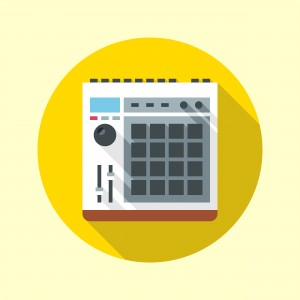
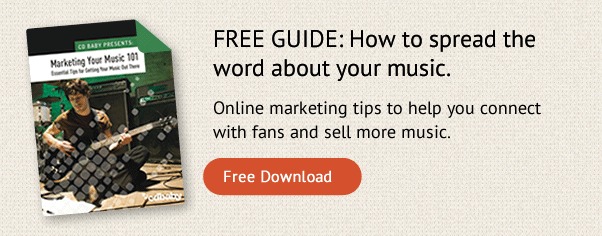
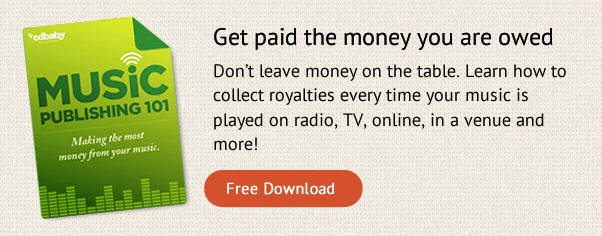
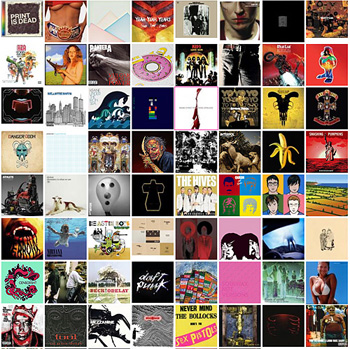

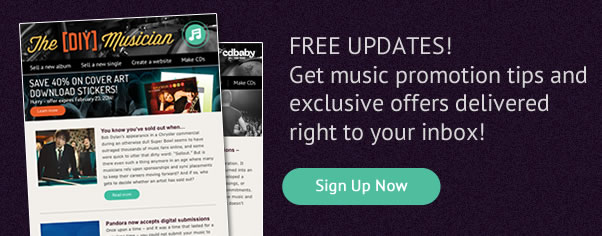
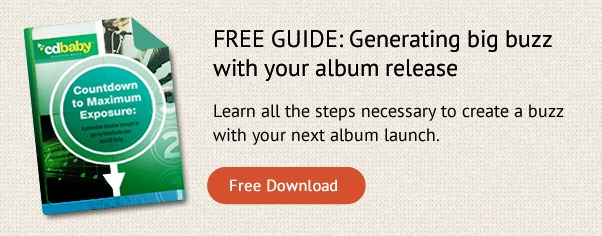

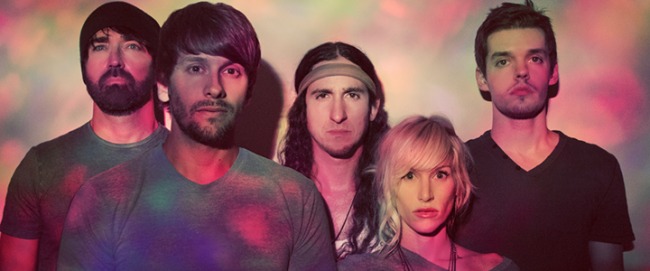
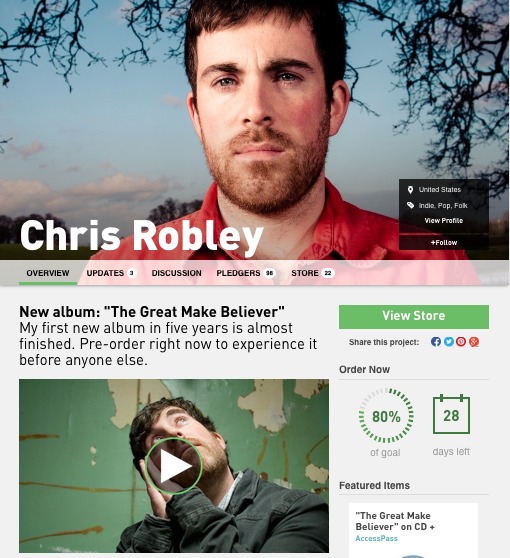

 And they have multiple campaign options for funding/pre-sales, including:
And they have multiple campaign options for funding/pre-sales, including:






